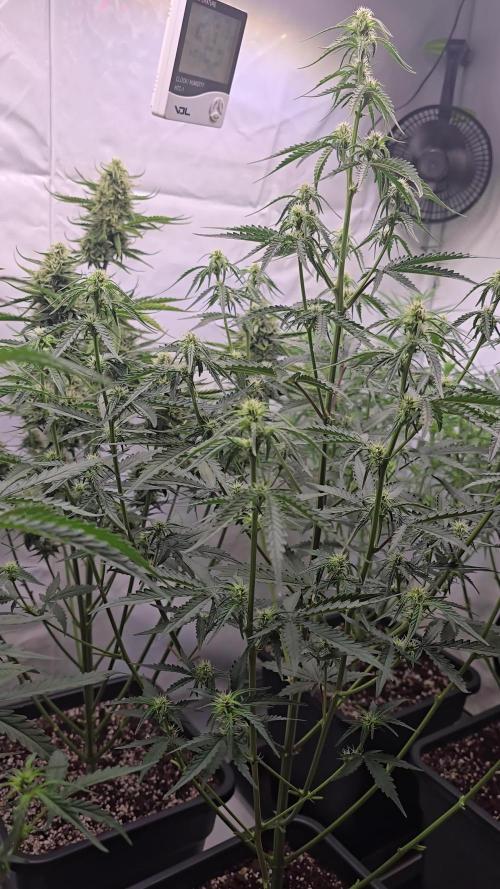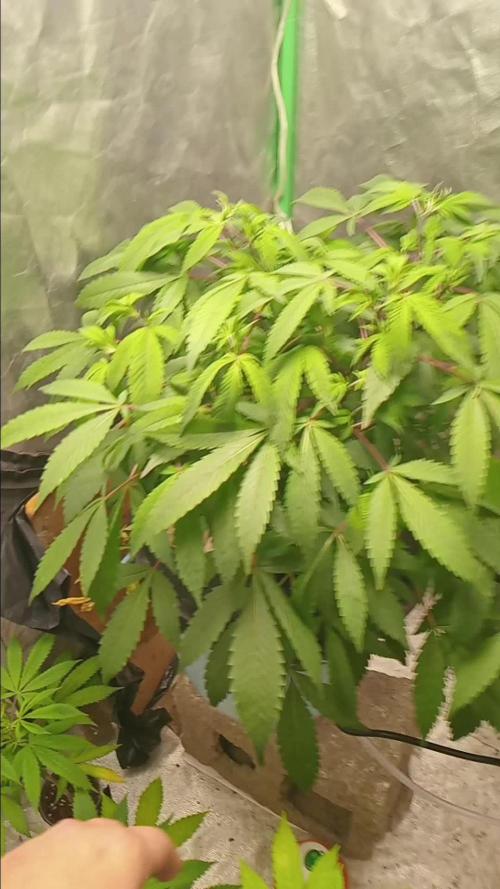The Grow Awards 2026 🏆 































Likes
3
Share


@Maddadanny
Follow
Neuen Topf bekommen und ins Blüte Zelt eingezogen ist Platz frei geworden.
Likes
145
Share


@Salokin
Follow
Hey Growmies,
All three of the ladies are developing as they should. Introduced sugar Royal to the mix, so far don’t see a difference, but the plants appear overall very healthy. Increased the ppfd to 269-300 as they grow larger.
Here is the code that’ll give you 20% in Zamnesia‘s online store, just input ZAMMIGD2023 at checkout.
Thanks for stepping by and until next week!
Likes
4
Share


@Bimli92
Follow
harvest, flower length 64 days, total growth time 88 days. Now wait for it to dry.
Likes
2
Share


@Stork
Follow
Day 1 Mon
PH 5.8
EC 0.5
PPM 260
DLI 19h
PPFD
Water 22
Day 2 Tue
PH 5.9
EC 0.5
PPM 270
DLI 19h
PPFD
Water 22
Day 5 Fri
PH 5.7
EC 0.5
PPM 270
DLI 19h
PPFD
Water 22
Likes
3
Share


@Bwright_315
Follow
Week 13 I wanted to harvest this week but the buds seem air still so I move my light closer to see if that help fatten up the buds.
Processing
Likes
43
Share


@Jack_Greenstalk
Follow
added trellis netting this week to start SCROG. two layers close to eachother so I don't have to wait for entire square of growth to tuck under higher growth to keep flat even canopy. also minimizes my need for zip tie and garden ties needinf adjustment. I'm happy with veg growth thus far, and once the screen fills up with more green in a week or two these two ladies will both be ready to flip to flower. waiting on lower nodes to develop a bit more and get best use I can from a big(ish) 315 w LEC light.
the girls are getting foliar every 3 or 4 days. using heavy 16 foliar only at the moment but will follow their foliar mix as grow progresses.
smell has gotten much heavier, especially in nemo, the more blueberry pheno of the two, looking at the fan leafs I think V is more haze pheno with super thin sativa leaf structure.
Processing
Likes
10
Share


@YAKDADDYDWC
Follow
Had major problems with temps rising this week was forced to pull out the aircon..... gona cost a fortune!!! To top it off i got gnats but 8 think im on top of it geez i have had some troubles from enviroment because its summer and i would have better results in winter
Likes
2
Share


@ThatsmyGrow
Follow
Sie scheint mit bisschen Lichtstress zu haben, aber da schauen wir einfach weg.
Likes
10
Share


@CanadianFillmore
Follow
Week 7 begins for Glueberry OG! She's also developed a hunger for more nutrients as temps have increased, so an extra liter of food she got, midway through the week. The OG kush genetics are much more noticeable during this second grow.
August 1 - added some close up pictures.
Likes
17
Share


@ScouseCityLX
Follow
Struggling now with temps due to weather getting warmer. Next week may be worse. Other than that all good, plants showing how they're going to end up kinda, some characteristics showing through now
Likes
18
Share


@Coopmc
Follow
Hear we go test growing the new batch of seeds!! So far nice split going on!
7 out of 10 split and planted!!
7 heads popping up!
Processing
Likes
16
Share


@Dunk_Junk
Follow
Well into flowering now.
She is definitely a more indica phenotype 😭
I must have lucked out first time round with such a Sativa phenotype 😍
I'd love to know more on this side. The likely phenotypes, and how and why they come about. Also what is the likelyhood/prevalence of each of the phenotypes.......
So many questions 😂
But anyway, she's looking absolutely fab. Flowers developing well so on she goes a few more weeks! 👌
Processing
Likes
4
Share


@Cannabot
Follow
Still feeding the same,she's very thirsty but considering the size etc it's understandable.Love the chocolope smell,still remember it from my last grow.Packing on bud atm.Should probably defoilate about 20% in the next day or so.
Likes
5
Share


@Bluemels
Follow
Tag 34: Auch die hintere Pflanze musste ich runterbiegen aus Platzgründen.
Processing
Likes
5
Share


@Mr_nugs_lover_David
Follow
One of the 2 seeds the #1 pheno didn't make it to the surface after 72 hours, so I'm gonna have to replace it with another same strain seed which is the last one I got. Let's see how this baby girl of hard diesel #2 perfoms.
Likes
4
Share


@MakFaso2022
Follow
Moby 2.0 : El que se ganó el lugar para florar en hidro el único de todos sus hmnos recibió un cambio de solución y paso a estar 12/12. Le había realizado una desfoliacion así que ya estaba preparado para la pre flora...
Trillisos Peones : Son 3 esquejes qué trasplante con tierra reciclada ya que no tenía para comprar como ya menciones en la semana anterior luego le agregue arriba un poco de sustrato nuevo hay 1 que se destaca va más avanzado, Cabe destacar que los mismos como estaban de hace bastante y por la edad que tienen ya estaban creando flor en sus pequeñas maletas por lo que decidí cambiarlos de urgencia y ponerlos a florar para sumar más producto final...























